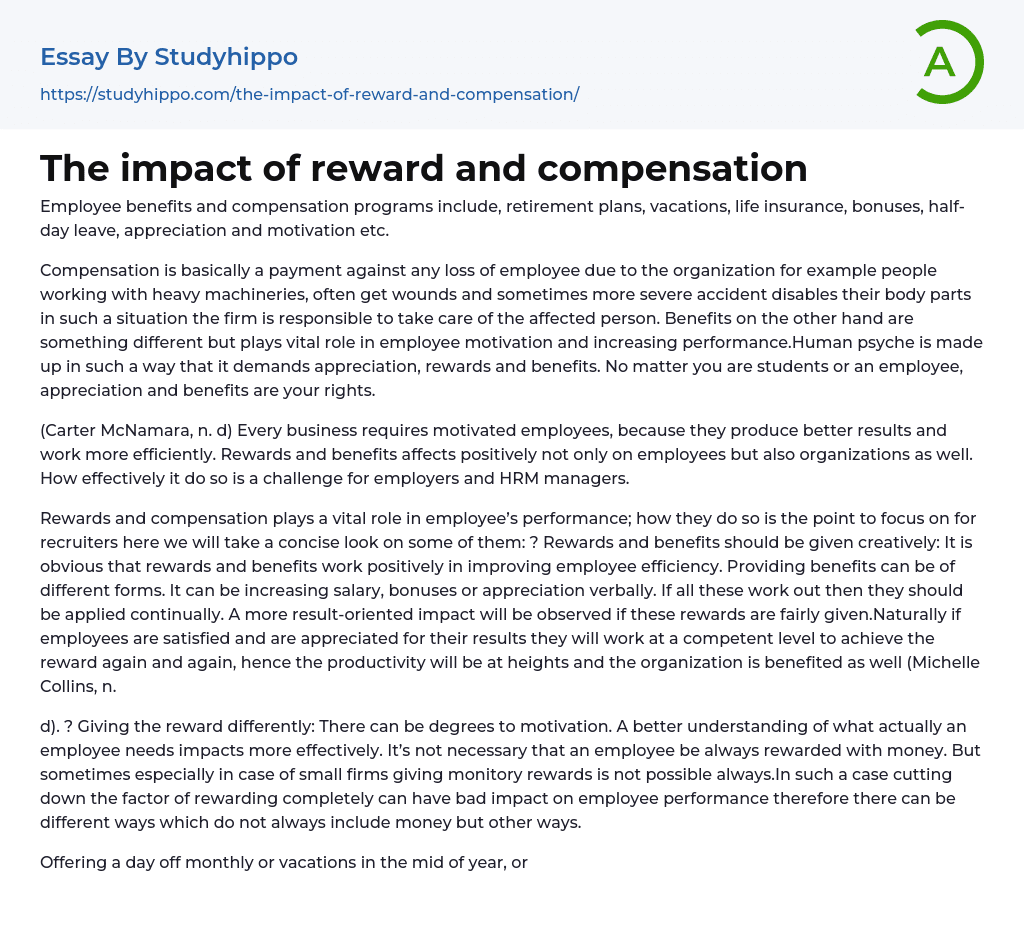Employee benefits and compensation programs encompass various offerings such as retirement plans, life insurance, vacation time, bonus incentives, half-day leave, and measures to show appreciation and increase motivation.
Compensation refers to the payment an organization provides to employees who suffer losses due to work-related injuries or disabilities. This includes those working with heavy machinery who may sustain wounds or suffer more severe accidents that disable their body parts. On the other hand, benefits are a separate but equally important factor in motivating employees and enhancing their performance. Because human nature craves appreciation, rewards, and benefits, both students and employees have the right to receive them.
(Carter McNamara, n. d) Motivated employees are essential for businesses to achieve better results and higher efficiency. Rewards and benefits have a positive impact on both employees and organizations. However, effectively
...implementing them is a challenge for employers and HRM managers.
Recruiters need to focus on how rewards and compensation positively impact employee performance. It is important to provide creative forms of rewards and benefits, such as salary increases, bonuses, and verbal appreciation, which should be consistently applied and fairly given. When employees are satisfied with their rewards and are appreciated for their results, they will be motivated to work competently to achieve similar rewards in the future. This leads to increased productivity for the organization as a whole (Michelle Collins, n.).
d) Motivating employees with varying reward methods: Motivation can come in different forms depending on individual needs of employees. Monetary rewards aren't the only option and may not always be possible, especially for small companies. Completely removing the reward factor can negatively affect performance, so alternative methods that don't always involve mone
should be considered.
According to Michelle Collins (n.d.) and Reilly P (1996), offering a day off monthly or mid-year vacations, as well as expressing words of kindness and appreciation, can significantly boost employee motivation. HRM is built on such ideas and tools that are essential in motivating employees and enhancing their productivity and efficiency. The primary objective of HRM is to maintain a conducive work environment, address employee issues, keep performance records, and implement employee reward systems to evaluate the impact on the organization and its workforce. In conclusion, HRM is the backbone of any organization, but it should be noted that employees are the soul of the company - teamwork is crucial, and motivation, rewards, and appreciation are crucial for success.
This paper focuses on two main aspects of HRM. Firstly, we examine the definition and significance of HRM. Additionally, we delve into the responsibility of rewarding employees and its extensive effects. By providing rewarding incentives, employee efficiency is significantly increased. This leads to an overall maximization of profits, which ultimately benefits the entire organization as a whole.
Understanding human psychology is a crucial factor in achieving business success. This involves recognizing and incentivizing hard work and effort. To implement effective methods of employee motivation, resources like Michelle Collins' "4 Ways to Reward Motivate Employees" and Carter McNamara's "Human Resources Management" can offer guidance. These resources were consulted on April 3, 2008.
The following webpage was accessed on April 3rd, 2008: http://www.managementhelp.org/hr_mgmnt/hr_mgmnt.htm. The webpage, authored by Carter McNamara, MBA, PhD, discusses employee benefits and compensation. Another resource on this topic can be found here: http://www.On the 3rd of April 08, the website soulbusiness.com/Lessons.htm#TOP was accessed. The
author of the book Human Resource Planning: an Introduction (1996), Reilly P, can be found at http://www.employment-studies.co.
Accessed on 3rd April 2008, the US Department of Labor's O*NET Online (http://www.bls.gov/oco/ocos021) and UK Summary (http://uk/summary/summary.php?id=312) are both sources worth exploring.
Accessed on 3rd April 08 via htm
- Performance essays
- Human Resources essays
- Recruitment essays
- Code of Ethics essays
- Organizational Behavior essays
- Dress Code essays
- Safety essays
- Conflict essays
- Qualities essays
- American Dream essays
- Barriers To Entry essays
- Capitalism essays
- Central Bank essays
- Compensation essays
- Consumerism essays
- Economic Development essays
- Economic Growth essays
- Economic Inequality essays
- Economic System essays
- Economy essays
- Employment essays
- Export essays
- Finance essays
- Free Trade essays
- Gross Domestic Product essays
- Human Development essays
- Income Inequality essays
- Industry essays
- Inflation essays
- International Business essays
- International Trade essays
- Macroeconomics essays
- Materialism essays
- Max Weber essays
- Microeconomics essays
- Minimum Wage essays
- Monetary Policy essays
- Monopoly essays
- Pricing essays
- Profit essays
- Recession essays
- resources essays
- Taxation essays
- Trade essays
- Unemployment essays
- Warehouse essays
- World economy essays
- Accounting essays
- Andrew Carnegie essays
- Automation essays




